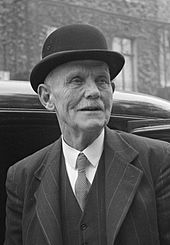-
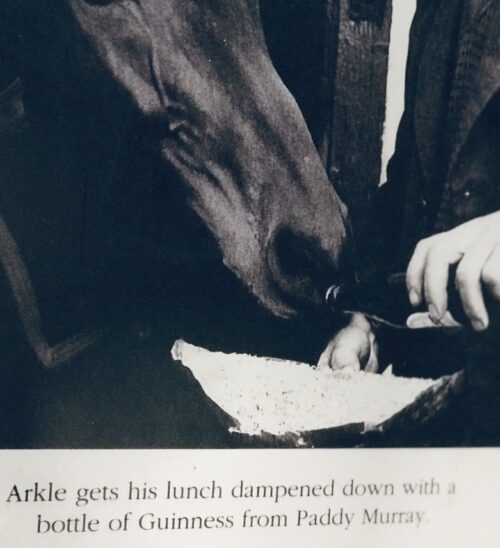
 Great picture of a recuperating Arkle getting his lunch washed down by a bottle of Guinness by his head lad Paddy Murray. Ratoath Co Meath. 50cm x 40cm Arkle (19 April 1957 – 31 May 1970) was an Irish Thoroughbred racehorse. A bay gelding by Archive out of Bright Cherry, he was the grandson of the unbeaten (in 14 races) flat racehorse and prepotent sire Nearco. Arkle was born at Ballymacoll Stud, County Meath, by Mrs Mary Alison Baker of Malahow House, near Naul, County Dublin. He was named after the mountain Arkle in Sutherland, Scotland that bordered the Duchess of Westminster’s Sutherland estate. Owned by Anne Grosvenor, Duchess of Westminster, he was trained by Tom Dreaper at Greenogue, Kilsallaghan in County Meath, Ireland, and ridden during his steeplechasing career by Pat Taaffe. At 212, his Timeform rating is the highest ever awarded to a steeplechaser. Only Flyingbolt, also trained by Dreaper, had a rating anywhere near his at 210. Next on their ratings are Sprinter Sacre on 192 and then Kauto Star and Mill House on 191. Despite his career being cut short by injury, Arkle won three Cheltenham Gold Cups, the Blue Riband of steeplechasing, and a host of other top prizes. On 19th April, 2014 a magnificent 1.1 scale bronze statue was unveiled in Ashbourne, County Meath in commemoration of Arkle.In the 1964 Cheltenham Gold Cup, Arkle beat Mill House (who had won the race the previous year) by five lengths to claim his first Gold Cup at odds of 7/4. It was the last time he did not start as the favourite for a race. Only two other horses entered the Gold Cup that year. The racing authorities in Ireland took the unprecedented step in the Irish Grand National of devising two weight systems — one to be used when Arkle was running and one when he was not. Arkle won the 1964 race by only one length, but he carried two and half stones more than his rivals. The following year's Gold Cup saw Arkle beat Mill House by twenty lengths at odds of 3/10. In the 1966 renewal, he was the shortest-priced favourite in history to win the Gold Cup, starting at odds of 1/10. He won the race by thirty lengths despite a mistake early in the race where he ploughed through a fence. However, it did not stop his momentum, nor did he ever look like falling. Arkle had a strange quirk in that he crossed his forelegs when jumping a fence. He went through the season 1965/66 unbeaten in five races. Arkle won 27 of his 35 starts and won at distances from 1m 6f up to 3m 5f. Legendary Racing commentator Peter O'Sullevan has called Arkle a freak of nature — something unlikely to be seen again. Besides winning three consecutive Cheltenham Gold Cups (1964, 1965, 1966) and the 1965 King George VI Chase, Arkle triumphed in a number of other important handicap chases, including the 1964 Irish Grand National (under 12-0), the 1964 and 1965 Hennessy Gold Cups (both times under 12-7), the 1965 Gallagher Gold Cup (conceding 16 lb to Mill House while breaking the course record by 17 seconds), and the 1965 Whitbread Gold Cup(under 12-7). In the 1966 Hennessy, he failed by only half a length to give Stalbridge Colonist 35 lb. The scale of the task Arkle faced is shown by the winner coming second and third in the two following Cheltenham Gold Cups, while in third place was the future 1969 Gold Cup winner, What A Myth. In December 1966, Arkle raced in the King George VI Chase at Kempton Park but struck the guard rail with a hoof when jumping the open ditch, which resulted in a fractured pedal bone; despite this injury, he completed the race and finished second. He was in plaster for four months and, though he made a good enough recovery to go back into training, he never ran again. He was retired and ridden as a hack by his owner and then succumbed to what has been variously described as advanced arthritis or possibly brucellosis and was put down at the early age of 13. Arkle became a national legend in Ireland. His strength was jokingly claimed to come from drinking 2 pints of Guinness a day. At one point, the slogan Arkle for President was written on a wall in Dublin. The horse was often referred to simply as "Himself", and he supposedly received items of fan mail addressed to 'Himself, Ireland'. The Irish government-owned Irish National Stud, at Tully, Kildare, Co. Kildare, Ireland, has the skeleton of Arkle on display in its museum. A statue in his memory was erected in Ashbourne Co Meath in 2004. Dimensions : 55cm x 60cm
Great picture of a recuperating Arkle getting his lunch washed down by a bottle of Guinness by his head lad Paddy Murray. Ratoath Co Meath. 50cm x 40cm Arkle (19 April 1957 – 31 May 1970) was an Irish Thoroughbred racehorse. A bay gelding by Archive out of Bright Cherry, he was the grandson of the unbeaten (in 14 races) flat racehorse and prepotent sire Nearco. Arkle was born at Ballymacoll Stud, County Meath, by Mrs Mary Alison Baker of Malahow House, near Naul, County Dublin. He was named after the mountain Arkle in Sutherland, Scotland that bordered the Duchess of Westminster’s Sutherland estate. Owned by Anne Grosvenor, Duchess of Westminster, he was trained by Tom Dreaper at Greenogue, Kilsallaghan in County Meath, Ireland, and ridden during his steeplechasing career by Pat Taaffe. At 212, his Timeform rating is the highest ever awarded to a steeplechaser. Only Flyingbolt, also trained by Dreaper, had a rating anywhere near his at 210. Next on their ratings are Sprinter Sacre on 192 and then Kauto Star and Mill House on 191. Despite his career being cut short by injury, Arkle won three Cheltenham Gold Cups, the Blue Riband of steeplechasing, and a host of other top prizes. On 19th April, 2014 a magnificent 1.1 scale bronze statue was unveiled in Ashbourne, County Meath in commemoration of Arkle.In the 1964 Cheltenham Gold Cup, Arkle beat Mill House (who had won the race the previous year) by five lengths to claim his first Gold Cup at odds of 7/4. It was the last time he did not start as the favourite for a race. Only two other horses entered the Gold Cup that year. The racing authorities in Ireland took the unprecedented step in the Irish Grand National of devising two weight systems — one to be used when Arkle was running and one when he was not. Arkle won the 1964 race by only one length, but he carried two and half stones more than his rivals. The following year's Gold Cup saw Arkle beat Mill House by twenty lengths at odds of 3/10. In the 1966 renewal, he was the shortest-priced favourite in history to win the Gold Cup, starting at odds of 1/10. He won the race by thirty lengths despite a mistake early in the race where he ploughed through a fence. However, it did not stop his momentum, nor did he ever look like falling. Arkle had a strange quirk in that he crossed his forelegs when jumping a fence. He went through the season 1965/66 unbeaten in five races. Arkle won 27 of his 35 starts and won at distances from 1m 6f up to 3m 5f. Legendary Racing commentator Peter O'Sullevan has called Arkle a freak of nature — something unlikely to be seen again. Besides winning three consecutive Cheltenham Gold Cups (1964, 1965, 1966) and the 1965 King George VI Chase, Arkle triumphed in a number of other important handicap chases, including the 1964 Irish Grand National (under 12-0), the 1964 and 1965 Hennessy Gold Cups (both times under 12-7), the 1965 Gallagher Gold Cup (conceding 16 lb to Mill House while breaking the course record by 17 seconds), and the 1965 Whitbread Gold Cup(under 12-7). In the 1966 Hennessy, he failed by only half a length to give Stalbridge Colonist 35 lb. The scale of the task Arkle faced is shown by the winner coming second and third in the two following Cheltenham Gold Cups, while in third place was the future 1969 Gold Cup winner, What A Myth. In December 1966, Arkle raced in the King George VI Chase at Kempton Park but struck the guard rail with a hoof when jumping the open ditch, which resulted in a fractured pedal bone; despite this injury, he completed the race and finished second. He was in plaster for four months and, though he made a good enough recovery to go back into training, he never ran again. He was retired and ridden as a hack by his owner and then succumbed to what has been variously described as advanced arthritis or possibly brucellosis and was put down at the early age of 13. Arkle became a national legend in Ireland. His strength was jokingly claimed to come from drinking 2 pints of Guinness a day. At one point, the slogan Arkle for President was written on a wall in Dublin. The horse was often referred to simply as "Himself", and he supposedly received items of fan mail addressed to 'Himself, Ireland'. The Irish government-owned Irish National Stud, at Tully, Kildare, Co. Kildare, Ireland, has the skeleton of Arkle on display in its museum. A statue in his memory was erected in Ashbourne Co Meath in 2004. Dimensions : 55cm x 60cm -
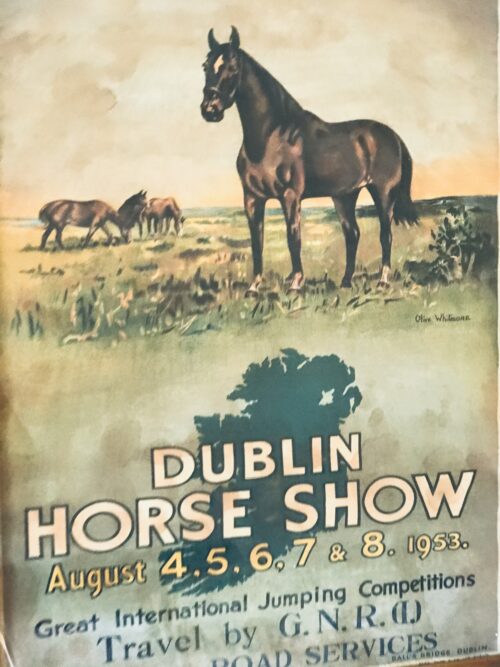
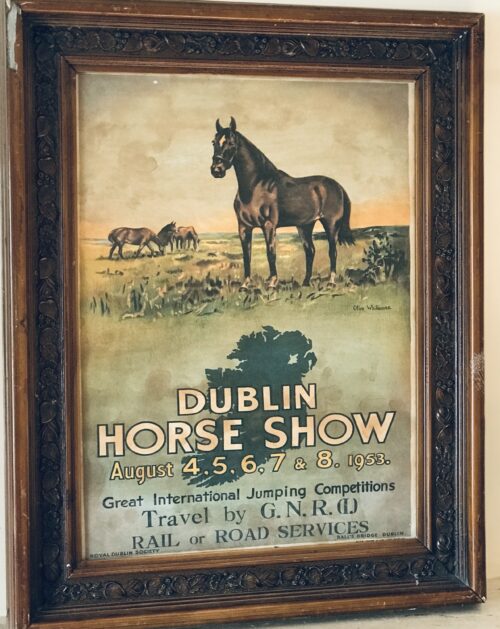 65cm x 52cm Naas Co Kildare RDS (Royal Dublin Society) Dublin Horse Show advertising print from August 1953 featuring a beautiful painting depicting horses at pasture by the artist Olive Whitmore.The advert was printed by Alex Thom & Co Ltd Dublin and also describes the various modes of transport available to prospective horseshow goers, namely the GNR or Great Northern Railway. This print is available as a high quality reproduction with an antique frame.For price details on the original ,please email us directly at irishpubemporium@gmail.com Founded in 1876,the GNR was a merger between the Irish North Western Railway,Northern Railway of Ireland and Ulster Railway.The company was nationalised later in 1953 before being finally liquidated 5 years later with its assets divided upon national lines between the Ulster Transport Authority & Ćoras Iompair Éireann (CIE). The first Dublin Horse Show took place in 1864 and was operated in conjunction with the Royal Agricultural Society of Ireland. The first solely Society-run Horse Show was held in 1868 and was one of the earliest "leaping" competitions ever held.Over time it has become a high-profile International show jumping competition, national showing competition and major entertainment event in Ireland. In 1982 the RDS hosted the Show Jumping World Championshipsand incorporated it into the Dublin Horse Show of that year. The Dublin Horse Show has an array of national & international show jumping competitions and world class equestrian entertainment, great shopping, delicious food, music & fantastic daily entertainment. There are over 130 classes at the Show and they can be generally categorised into the following types of equestrian competitions: showing classes, performance classes and showjumping classes.
65cm x 52cm Naas Co Kildare RDS (Royal Dublin Society) Dublin Horse Show advertising print from August 1953 featuring a beautiful painting depicting horses at pasture by the artist Olive Whitmore.The advert was printed by Alex Thom & Co Ltd Dublin and also describes the various modes of transport available to prospective horseshow goers, namely the GNR or Great Northern Railway. This print is available as a high quality reproduction with an antique frame.For price details on the original ,please email us directly at irishpubemporium@gmail.com Founded in 1876,the GNR was a merger between the Irish North Western Railway,Northern Railway of Ireland and Ulster Railway.The company was nationalised later in 1953 before being finally liquidated 5 years later with its assets divided upon national lines between the Ulster Transport Authority & Ćoras Iompair Éireann (CIE). The first Dublin Horse Show took place in 1864 and was operated in conjunction with the Royal Agricultural Society of Ireland. The first solely Society-run Horse Show was held in 1868 and was one of the earliest "leaping" competitions ever held.Over time it has become a high-profile International show jumping competition, national showing competition and major entertainment event in Ireland. In 1982 the RDS hosted the Show Jumping World Championshipsand incorporated it into the Dublin Horse Show of that year. The Dublin Horse Show has an array of national & international show jumping competitions and world class equestrian entertainment, great shopping, delicious food, music & fantastic daily entertainment. There are over 130 classes at the Show and they can be generally categorised into the following types of equestrian competitions: showing classes, performance classes and showjumping classes.- The first show was held in 1864 under the auspices of the Society, but organised by the Royal Agricultural Society of Ireland.
- There were 366 entries in the first Show with a total prize fund of £520.
- On the 28, 29 and 30 July 1868 the first show was held and organised by the Royal Dublin Society on the lawns of Leinster House. The Council granted £100 out of the Society's funds to be awarded in prizes. It started as a show of led-horses and featured ‘leaping' demonstrations.
- The first prize for the Stone Wall competition (6ft) in 1868 was won by Richard Flynn on hunter, Shane Rhue (who sold for £1,000 later that day).
- Ass and mule classes were listed at the first show!
- In 1869 the first Challenge Cup was presented for the best exhibit in the classes for hunters and young horses likely to make hunters.
- In 1870 the Show was named ‘The National Horse Show', taking place on the 16-19 August. It was combined with the Annual Sheep Show organised by the Society.
- 1869 was the year ‘horse leaping' came to prominence. There was the high leap over hurdles trimmed with gorse; the wall jump over a loose stone wall of progressive height not exceeding 6 feet; and the wide leap over 2 ½ ft gorse-filled hurdle with 12 ft of water on the far side.
- The original rules for the leaping competitions were simply ‘the obstacles had to be cleared to the satisfaction of the judges'.
- The prizes for the high and wide leaps were £5 for first and £2 for second with £10 and a cup to the winner of the championship and a riding crop and a fiver to the runner up.
- In 1881 the Show moved to ‘Ball's Bridge', a greenfield site. The first continuous ‘leaping' course was introduced at the Show.
- In 1881 the first viewing stand was erected on the site of the present Grand Stand. It held 800 people.
- With over 800 entries in the Show in 1895, it was necessary to run the jumping competitors off in pairs - causing difficulties for the judges at the time!
- Women first took part in jumping competitions from 1919.
- A class for women was introduced that year on the second day of the Show (Wednesday was the second day of the Show in 1919. Ladies' Day moved to Thursday, the second day, when the Show went from six to five days). Quickly after that, from the 1920s onwards, women were able to compete freely in many competitions at the Show.
- Women competed in international competitions representing their country shortly after WWII.
- As the first "Ladies' Jumping Competition" was held on the second day of the Show this day become known as Ladies' Day. A name that has stuck ever since.
- In 1925 Colonel Zeigler of the Swiss Army first suggested holding an international jumping event. The Aga Khan of the time heard of this proposal and offered a challenge trophy to the winner of the competition.
- In 1926 International Competitions were introduced to the show and was the first time the Nations' Cup for the Aga Khan Challenge trophy was held.
- Six countries competed in the first international teams competition for the Aga Khan Challenge trophy - Great Britain, Holland, Belgium, France, Switzerland and Ireland. The Swiss team won the title on Irish bred horses.
- The Swiss team won out the original trophy in 1930. Ireland won the first replacement in 1937 and another in 1979, Britain in 1953 and 1975. The present trophy is the sixth in the series and was presented by His Highness the Aga Khan in 1980.
- Up until 1949 the Nations' Cup teams had to consist of military officers.
- The first Grand Prix (Irish Trophy) held in 1934 was won by Comdt.J.D.(Jed) O'Dwyer, of the Army Equitation school. The Irish Trophy becomes the possession of the rider if it is won three times in succession or four times in all.
- The first timed jumping competition was held in 1938. In 1951 an electric clock was installed and the time factor entered most competitions.
- In 1976, after 50 years of international competition, the two grass banks in the Arena were removed so the Arena could be used for other events. The continental band at the western end of the Main Arena was added later.
- Shows have been held annually except from 1914-1919 due to WW1 and from 1940-1946 due to WW2.
- In 2003 the Nations Cup Competition for the Aga Khan Trophy became part of the Samsung Super League under the auspices of the Federation Equestre Internationale.
- The Nations Cup Competition for the Aga Khan Trophy is part of the Longines FEI Jumping Nations Cup™ Series.
- The Dublin Horse Show is Ireland's largest equestrian event, and one of the largest events held on the island.
- The Show has one of the largest annual prize pools for international show jumping in the world.
-

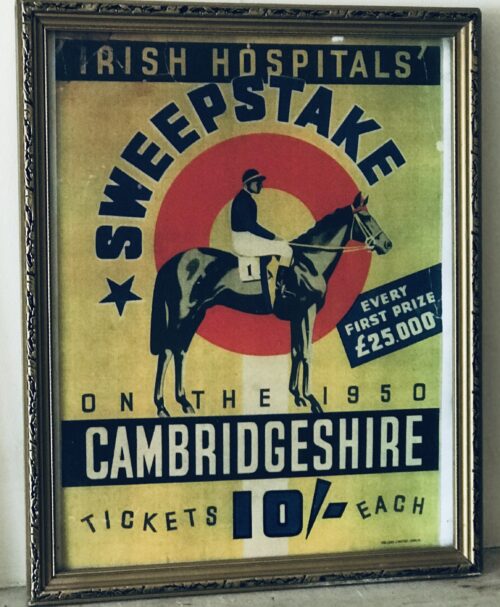 Fine print advertising the 1950 Irish Hospital Sweepstake for the horserace ,the Irish Cambridgeshire Handicap. The Irish Hospital Sweepstake was a lottery established in the Irish Free State in 1930 as the Irish Free State Hospitals' Sweepstake to finance hospitals. It is generally referred to as the Irish Sweepstake, frequently abbreviated to Irish Sweeps or Irish Sweep. The Public Charitable Hospitals (Temporary Provisions) Act, 1930 was the act that established the lottery; as this act expired in 1934, in accordance with its terms, the Public Hospitals Acts were the legislative basis for the scheme thereafter. The main organisers were Richard Duggan, Captain Spencer Freeman and Joe McGrath. Duggan was a well known Dublin bookmaker who had organised a number of sweepstakes in the decade prior to setting up the Hospitals' Sweepstake. Captain Freeman was a Welsh-born engineer and former captain in the British Army. After the Constitution of Ireland was enacted in 1937, the name Irish Hospitals' Sweepstake was adopted. The sweepstake was established because there was a need for investment in hospitals and medical services and the public finances were unable to meet this expense at the time. As the people of Ireland were unable to raise sufficient funds, because of the low population, a significant amount of the funds were raised in the United Kingdom and United States, often among the emigrant Irish. Potentially winning tickets were drawn from rotating drums, usually by nurses in uniform. Each such ticket was assigned to a horse expected to run in one of several horse races, including the Cambridgeshire Handicap, Derby and Grand National. Tickets that drew the favourite horses thus stood a higher likelihood of winning and a series of winning horses had to be chosen on the accumulator system, allowing for enormous prizes. The original sweepstake draws were held at The Mansion House, Dublin on 19 May 1939 under the supervision of the Chief Commissioner of Police, and were moved to the more permanent fixture at the Royal Dublin Society (RDS) in Ballsbridge later in 1940. The Adelaide Hospital in Dublin was the only hospital at the time not to accept money from the Hospitals Trust, as the governors disapproved of sweepstakes. From the 1960s onwards, revenues declined. The offices were moved to Lotamore House in Cork. Although giving the appearance of a public charitable lottery, with nurses featured prominently in the advertising and drawings, the Sweepstake was in fact a private for-profit lottery company, and the owners were paid substantial dividends from the profits. Fortune Magazine described it as "a private company run for profit and its handful of stockholders have used their earnings from the sweepstakes to build a group of industrial enterprises that loom quite large in the modest Irish economy. Waterford Glass, Irish Glass Bottle Company and many other new Irish companies were financed by money from this enterprise and up to 5,000 people were given jobs."[3] By his death in 1966, Joe McGrath had interests in the racing industry, and held the Renault dealership for Ireland besides large financial and property assets. He was known throughout Ireland for his tough business attitude but also by his generous spirit.At that time, Ireland was still one of the poorer countries in Europe; he believed in investment in Ireland. His home, Cabinteely House, was donated to the state in 1986. The house and the surrounding park are now in the ownership of Dún Laoghaire–Rathdown County Council who have invested in restoring and maintaining the house and grounds as a public park. In 1986, the Irish government created a new public lottery, and the company failed to secure the new contract to manage it. The final sweepstake was held in January 1986 and the company was unsuccessful for a licence bid for the Irish National Lottery, which was won by An Post later that year. The company went into voluntary liquidation in March 1987. The majority of workers did not have a pension scheme but the sweepstake had fed many families during lean times and was regarded as a safe job.The Public Hospitals (Amendment) Act, 1990 was enacted for the orderly winding up of the scheme which had by then almost £500,000 in unclaimed prizes and accrued interest. A collection of advertising material relating to the Irish Hospitals' Sweepstakes is among the Special Collections of National Irish Visual Arts Library. At the time of the Sweepstake's inception, lotteries were generally illegal in the United Kingdom, the United States and Canada. In the absence of other readily available lotteries, the Irish Sweeps became popular. Even though tickets were illegal outside Ireland, millions were sold in the US and Great Britain. How many of these tickets failed to make it back for the drawing is unknown. The United States Customs Service alone confiscated and destroyed several million counterfoils from shipments being returned to Ireland. In the UK, the sweepstakes caused some strain in Anglo-Irish relations, and the Betting and Lotteries Act 1934 was passed by the parliament of the UK to prevent export and import of lottery related materials. The United States Congress had outlawed the use of the US Postal Service for lottery purposes in 1890. A thriving black market sprang up for tickets in both jurisdictions. From the 1950s onwards, as the American, British and Canadian governments relaxed their attitudes towards this form of gambling, and went into the lottery business themselves, the Irish Sweeps, never legal in the United States,declined in popularity. Origins: Co Galway Dimensions :39cm x 31cm
Fine print advertising the 1950 Irish Hospital Sweepstake for the horserace ,the Irish Cambridgeshire Handicap. The Irish Hospital Sweepstake was a lottery established in the Irish Free State in 1930 as the Irish Free State Hospitals' Sweepstake to finance hospitals. It is generally referred to as the Irish Sweepstake, frequently abbreviated to Irish Sweeps or Irish Sweep. The Public Charitable Hospitals (Temporary Provisions) Act, 1930 was the act that established the lottery; as this act expired in 1934, in accordance with its terms, the Public Hospitals Acts were the legislative basis for the scheme thereafter. The main organisers were Richard Duggan, Captain Spencer Freeman and Joe McGrath. Duggan was a well known Dublin bookmaker who had organised a number of sweepstakes in the decade prior to setting up the Hospitals' Sweepstake. Captain Freeman was a Welsh-born engineer and former captain in the British Army. After the Constitution of Ireland was enacted in 1937, the name Irish Hospitals' Sweepstake was adopted. The sweepstake was established because there was a need for investment in hospitals and medical services and the public finances were unable to meet this expense at the time. As the people of Ireland were unable to raise sufficient funds, because of the low population, a significant amount of the funds were raised in the United Kingdom and United States, often among the emigrant Irish. Potentially winning tickets were drawn from rotating drums, usually by nurses in uniform. Each such ticket was assigned to a horse expected to run in one of several horse races, including the Cambridgeshire Handicap, Derby and Grand National. Tickets that drew the favourite horses thus stood a higher likelihood of winning and a series of winning horses had to be chosen on the accumulator system, allowing for enormous prizes. The original sweepstake draws were held at The Mansion House, Dublin on 19 May 1939 under the supervision of the Chief Commissioner of Police, and were moved to the more permanent fixture at the Royal Dublin Society (RDS) in Ballsbridge later in 1940. The Adelaide Hospital in Dublin was the only hospital at the time not to accept money from the Hospitals Trust, as the governors disapproved of sweepstakes. From the 1960s onwards, revenues declined. The offices were moved to Lotamore House in Cork. Although giving the appearance of a public charitable lottery, with nurses featured prominently in the advertising and drawings, the Sweepstake was in fact a private for-profit lottery company, and the owners were paid substantial dividends from the profits. Fortune Magazine described it as "a private company run for profit and its handful of stockholders have used their earnings from the sweepstakes to build a group of industrial enterprises that loom quite large in the modest Irish economy. Waterford Glass, Irish Glass Bottle Company and many other new Irish companies were financed by money from this enterprise and up to 5,000 people were given jobs."[3] By his death in 1966, Joe McGrath had interests in the racing industry, and held the Renault dealership for Ireland besides large financial and property assets. He was known throughout Ireland for his tough business attitude but also by his generous spirit.At that time, Ireland was still one of the poorer countries in Europe; he believed in investment in Ireland. His home, Cabinteely House, was donated to the state in 1986. The house and the surrounding park are now in the ownership of Dún Laoghaire–Rathdown County Council who have invested in restoring and maintaining the house and grounds as a public park. In 1986, the Irish government created a new public lottery, and the company failed to secure the new contract to manage it. The final sweepstake was held in January 1986 and the company was unsuccessful for a licence bid for the Irish National Lottery, which was won by An Post later that year. The company went into voluntary liquidation in March 1987. The majority of workers did not have a pension scheme but the sweepstake had fed many families during lean times and was regarded as a safe job.The Public Hospitals (Amendment) Act, 1990 was enacted for the orderly winding up of the scheme which had by then almost £500,000 in unclaimed prizes and accrued interest. A collection of advertising material relating to the Irish Hospitals' Sweepstakes is among the Special Collections of National Irish Visual Arts Library. At the time of the Sweepstake's inception, lotteries were generally illegal in the United Kingdom, the United States and Canada. In the absence of other readily available lotteries, the Irish Sweeps became popular. Even though tickets were illegal outside Ireland, millions were sold in the US and Great Britain. How many of these tickets failed to make it back for the drawing is unknown. The United States Customs Service alone confiscated and destroyed several million counterfoils from shipments being returned to Ireland. In the UK, the sweepstakes caused some strain in Anglo-Irish relations, and the Betting and Lotteries Act 1934 was passed by the parliament of the UK to prevent export and import of lottery related materials. The United States Congress had outlawed the use of the US Postal Service for lottery purposes in 1890. A thriving black market sprang up for tickets in both jurisdictions. From the 1950s onwards, as the American, British and Canadian governments relaxed their attitudes towards this form of gambling, and went into the lottery business themselves, the Irish Sweeps, never legal in the United States,declined in popularity. Origins: Co Galway Dimensions :39cm x 31cmThe Irish Hospitals Sweepstake was established because there was a need for investment in hospitals and medical services and the public finances were unable to meet this expense at the time. As the people of Ireland were unable to raise sufficient funds, because of the low population, a significant amount of the funds were raised in the United Kingdom and United States, often among the emigrant Irish. Potentially winning tickets were drawn from rotating drums, usually by nurses in uniform. Each such ticket was assigned to a horse expected to run in one of several horse races, including the Cambridgeshire Handicap, Derby and Grand National. Tickets that drew the favourite horses thus stood a higher likelihood of winning and a series of winning horses had to be chosen on the accumulator system, allowing for enormous prizes.
The original sweepstake draws were held at The Mansion House, Dublin on 19 May 1939 under the supervision of the Chief Commissioner of Police, and were moved to the more permanent fixture at the Royal Dublin Society (RDS) in Ballsbridge later in 1940. The Adelaide Hospital in Dublin was the only hospital at the time not to accept money from the Hospitals Trust, as the governors disapproved of sweepstakes. From the 1960s onwards, revenues declined. The offices were moved to Lotamore House in Cork. Although giving the appearance of a public charitable lottery, with nurses featured prominently in the advertising and drawings, the Sweepstake was in fact a private for-profit lottery company, and the owners were paid substantial dividends from the profits. Fortune Magazine described it as "a private company run for profit and its handful of stockholders have used their earnings from the sweepstakes to build a group of industrial enterprises that loom quite large in the modest Irish economy. Waterford Glass, Irish Glass Bottle Company and many other new Irish companies were financed by money from this enterprise and up to 5,000 people were given jobs."By his death in 1966, Joe McGrath had interests in the racing industry, and held the Renault dealership for Ireland besides large financial and property assets. He was known throughout Ireland for his tough business attitude but also by his generous spirit. At that time, Ireland was still one of the poorer countries in Europe; he believed in investment in Ireland. His home, Cabinteely House, was donated to the state in 1986. The house and the surrounding park are now in the ownership of Dún Laoghaire–Rathdown County Council who have invested in restoring and maintaining the house and grounds as a public park. In 1986, the Irish government created a new public lottery, and the company failed to secure the new contract to manage it. The final sweepstake was held in January 1986 and the company was unsuccessful for a licence bid for the Irish National Lottery, which was won by An Post later that year. The company went into voluntary liquidation in March 1987. The majority of workers did not have a pension scheme but the sweepstake had fed many families during lean times and was regarded as a safe job.The Public Hospitals (Amendment) Act, 1990 was enacted for the orderly winding up of the scheme,which had by then almost £500,000 in unclaimed prizes and accrued interest. A collection of advertising material relating to the Irish Hospitals' Sweepstakes is among the Special Collections of National Irish Visual Arts Library.In the United Kingdom and North America[edit]
At the time of the Sweepstake's inception, lotteries were generally illegal in the United Kingdom, the United States and Canada. In the absence of other readily available lotteries, the Irish Sweeps became popular. Even though tickets were illegal outside Ireland, millions were sold in the US and Great Britain. How many of these tickets failed to make it back for the drawing is unknown. The United States Customs Service alone confiscated and destroyed several million counterfoils from shipments being returned to Ireland. In the UK, the sweepstakes caused some strain in Anglo-Irish relations, and the Betting and Lotteries Act 1934 was passed by the parliament of the UK to prevent export and import of lottery related materials.[6][7] The United States Congress had outlawed the use of the US Postal Service for lottery purposes in 1890. A thriving black market sprang up for tickets in both jurisdictions. From the 1950s onwards, as the American, British and Canadian governments relaxed their attitudes towards this form of gambling, and went into the lottery business themselves, the Irish Sweeps, never legal in the United States,[8]:227 declined in popularity. -
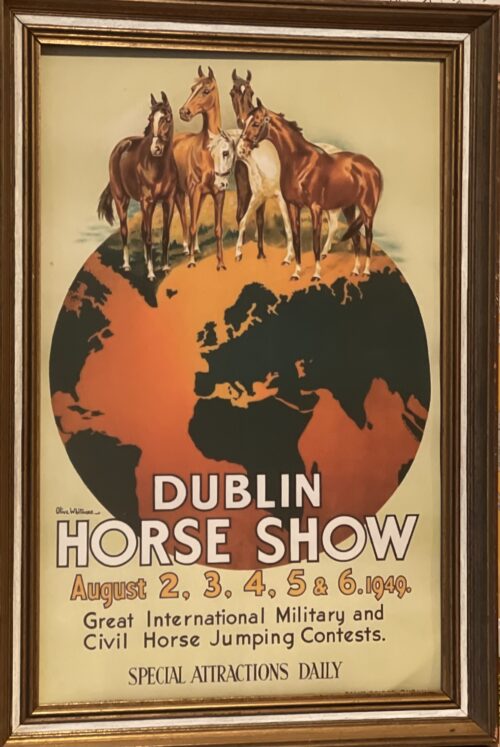
 68cm x 45cm Naas Co Kildare The first Dublin Horse Show took place in 1864 and was operated in conjunction with the Royal Agricultural Society of Ireland. The first solely Society-run Horse Show was held in 1868 and was one of the earliest "leaping" competitions ever held.Over time it has become a high-profile International show jumping competition, national showing competition and major entertainment event in Ireland. In 1982 the RDS hosted the Show Jumping World Championshipsand incorporated it into the Dublin Horse Show of that year. The Dublin Horse Show has an array of national & international show jumping competitions and world class equestrian entertainment, great shopping, delicious food, music & fantastic daily entertainment. There are over 130 classes at the Show and they can be generally categorised into the following types of equestrian competitions: showing classes, performance classes and showjumping classes.
68cm x 45cm Naas Co Kildare The first Dublin Horse Show took place in 1864 and was operated in conjunction with the Royal Agricultural Society of Ireland. The first solely Society-run Horse Show was held in 1868 and was one of the earliest "leaping" competitions ever held.Over time it has become a high-profile International show jumping competition, national showing competition and major entertainment event in Ireland. In 1982 the RDS hosted the Show Jumping World Championshipsand incorporated it into the Dublin Horse Show of that year. The Dublin Horse Show has an array of national & international show jumping competitions and world class equestrian entertainment, great shopping, delicious food, music & fantastic daily entertainment. There are over 130 classes at the Show and they can be generally categorised into the following types of equestrian competitions: showing classes, performance classes and showjumping classes.- The first show was held in 1864 under the auspices of the Society, but organised by the Royal Agricultural Society of Ireland.
- There were 366 entries in the first Show with a total prize fund of £520.
- On the 28, 29 and 30 July 1868 the first show was held and organised by the Royal Dublin Society on the lawns of Leinster House. The Council granted £100 out of the Society's funds to be awarded in prizes. It started as a show of led-horses and featured ‘leaping' demonstrations.
- The first prize for the Stone Wall competition (6ft) in 1868 was won by Richard Flynn on hunter, Shane Rhue (who sold for £1,000 later that day).
- Ass and mule classes were listed at the first show!
- In 1869 the first Challenge Cup was presented for the best exhibit in the classes for hunters and young horses likely to make hunters.
- In 1870 the Show was named ‘The National Horse Show', taking place on the 16-19 August. It was combined with the Annual Sheep Show organised by the Society.
- 1869 was the year ‘horse leaping' came to prominence. There was the high leap over hurdles trimmed with gorse; the wall jump over a loose stone wall of progressive height not exceeding 6 feet; and the wide leap over 2 ½ ft gorse-filled hurdle with 12 ft of water on the far side.
- The original rules for the leaping competitions were simply ‘the obstacles had to be cleared to the satisfaction of the judges'.
- The prizes for the high and wide leaps were £5 for first and £2 for second with £10 and a cup to the winner of the championship and a riding crop and a fiver to the runner up.
- In 1881 the Show moved to ‘Ball's Bridge', a greenfield site. The first continuous ‘leaping' course was introduced at the Show.
- In 1881 the first viewing stand was erected on the site of the present Grand Stand. It held 800 people.
- With over 800 entries in the Show in 1895, it was necessary to run the jumping competitors off in pairs - causing difficulties for the judges at the time!
- Women first took part in jumping competitions from 1919.
- A class for women was introduced that year on the second day of the Show (Wednesday was the second day of the Show in 1919. Ladies' Day moved to Thursday, the second day, when the Show went from six to five days). Quickly after that, from the 1920s onwards, women were able to compete freely in many competitions at the Show.
- Women competed in international competitions representing their country shortly after WWII.
- As the first "Ladies' Jumping Competition" was held on the second day of the Show this day become known as Ladies' Day. A name that has stuck ever since.
- In 1925 Colonel Zeigler of the Swiss Army first suggested holding an international jumping event. The Aga Khan of the time heard of this proposal and offered a challenge trophy to the winner of the competition.
- In 1926 International Competitions were introduced to the show and was the first time the Nations' Cup for the Aga Khan Challenge trophy was held.
- Six countries competed in the first international teams competition for the Aga Khan Challenge trophy - Great Britain, Holland, Belgium, France, Switzerland and Ireland. The Swiss team won the title on Irish bred horses.
- The Swiss team won out the original trophy in 1930. Ireland won the first replacement in 1937 and another in 1979, Britain in 1953 and 1975. The present trophy is the sixth in the series and was presented by His Highness the Aga Khan in 1980.
- Up until 1949 the Nations' Cup teams had to consist of military officers.
- The first Grand Prix (Irish Trophy) held in 1934 was won by Comdt.J.D.(Jed) O'Dwyer, of the Army Equitation school. The Irish Trophy becomes the possession of the rider if it is won three times in succession or four times in all.
- The first timed jumping competition was held in 1938. In 1951 an electric clock was installed and the time factor entered most competitions.
- In 1976, after 50 years of international competition, the two grass banks in the Arena were removed so the Arena could be used for other events. The continental band at the western end of the Main Arena was added later.
- Shows have been held annually except from 1914-1919 due to WW1 and from 1940-1946 due to WW2.
- In 2003 the Nations Cup Competition for the Aga Khan Trophy became part of the Samsung Super League under the auspices of the Federation Equestre Internationale.
- The Nations Cup Competition for the Aga Khan Trophy is part of the Longines FEI Jumping Nations Cup™ Series.
- The Dublin Horse Show is Ireland's largest equestrian event, and one of the largest events held on the island.
- The Show has one of the largest annual prize pools for international show jumping in the world.
-

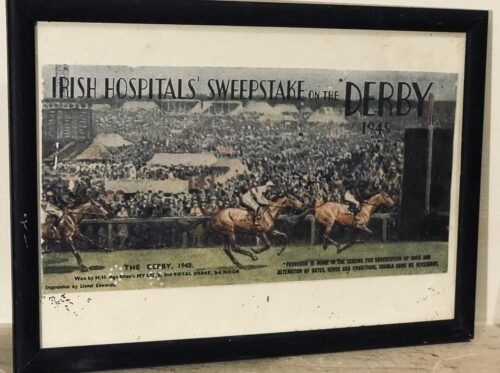 Enlarged ,framed ticket stub for the 1949 Irish Hospital Sweepstake for the Epsom Derby. Dublin 23cm x 31cm The Irish Hospital Sweepstake was a lottery established in the Irish Free State in 1930 as the Irish Free State Hospitals' Sweepstake to finance hospitals. It is generally referred to as the Irish Sweepstake, frequently abbreviated to Irish Sweeps or Irish Sweep. The Public Charitable Hospitals (Temporary Provisions) Act, 1930 was the act that established the lottery; as this act expired in 1934, in accordance with its terms, the Public Hospitals Acts were the legislative basis for the scheme thereafter. The main organisers were Richard Duggan, Captain Spencer Freeman and Joe McGrath. Duggan was a well known Dublin bookmaker who had organised a number of sweepstakes in the decade prior to setting up the Hospitals' Sweepstake. Captain Freeman was a Welsh-born engineer and former captain in the British Army. After the Constitution of Ireland was enacted in 1937, the name Irish Hospitals' Sweepstake was adopted. The sweepstake was established because there was a need for investment in hospitals and medical services and the public finances were unable to meet this expense at the time. As the people of Ireland were unable to raise sufficient funds, because of the low population, a significant amount of the funds were raised in the United Kingdom and United States, often among the emigrant Irish. Potentially winning tickets were drawn from rotating drums, usually by nurses in uniform. Each such ticket was assigned to a horse expected to run in one of several horse races, including the Cambridgeshire Handicap, Derby and Grand National. Tickets that drew the favourite horses thus stood a higher likelihood of winning and a series of winning horses had to be chosen on the accumulator system, allowing for enormous prizes. The original sweepstake draws were held at The Mansion House, Dublin on 19 May 1939 under the supervision of the Chief Commissioner of Police, and were moved to the more permanent fixture at the Royal Dublin Society (RDS) in Ballsbridge later in 1940. The Adelaide Hospital in Dublin was the only hospital at the time not to accept money from the Hospitals Trust, as the governors disapproved of sweepstakes. From the 1960s onwards, revenues declined. The offices were moved to Lotamore House in Cork. Although giving the appearance of a public charitable lottery, with nurses featured prominently in the advertising and drawings, the Sweepstake was in fact a private for-profit lottery company, and the owners were paid substantial dividends from the profits. Fortune Magazine described it as "a private company run for profit and its handful of stockholders have used their earnings from the sweepstakes to build a group of industrial enterprises that loom quite large in the modest Irish economy. Waterford Glass, Irish Glass Bottle Company and many other new Irish companies were financed by money from this enterprise and up to 5,000 people were given jobs."[3] By his death in 1966, Joe McGrath had interests in the racing industry, and held the Renault dealership for Ireland besides large financial and property assets. He was known throughout Ireland for his tough business attitude but also by his generous spirit.At that time, Ireland was still one of the poorer countries in Europe; he believed in investment in Ireland. His home, Cabinteely House, was donated to the state in 1986. The house and the surrounding park are now in the ownership of Dún Laoghaire–Rathdown County Council who have invested in restoring and maintaining the house and grounds as a public park. In 1986, the Irish government created a new public lottery, and the company failed to secure the new contract to manage it. The final sweepstake was held in January 1986 and the company was unsuccessful for a licence bid for the Irish National Lottery, which was won by An Post later that year. The company went into voluntary liquidation in March 1987. The majority of workers did not have a pension scheme but the sweepstake had fed many families during lean times and was regarded as a safe job.The Public Hospitals (Amendment) Act, 1990 was enacted for the orderly winding up of the scheme which had by then almost £500,000 in unclaimed prizes and accrued interest. A collection of advertising material relating to the Irish Hospitals' Sweepstakes is among the Special Collections of National Irish Visual Arts Library. At the time of the Sweepstake's inception, lotteries were generally illegal in the United Kingdom, the United States and Canada. In the absence of other readily available lotteries, the Irish Sweeps became popular. Even though tickets were illegal outside Ireland, millions were sold in the US and Great Britain. How many of these tickets failed to make it back for the drawing is unknown. The United States Customs Service alone confiscated and destroyed several million counterfoils from shipments being returned to Ireland. In the UK, the sweepstakes caused some strain in Anglo-Irish relations, and the Betting and Lotteries Act 1934 was passed by the parliament of the UK to prevent export and import of lottery related materials. The United States Congress had outlawed the use of the US Postal Service for lottery purposes in 1890. A thriving black market sprang up for tickets in both jurisdictions. From the 1950s onwards, as the American, British and Canadian governments relaxed their attitudes towards this form of gambling, and went into the lottery business themselves, the Irish Sweeps, never legal in the United States,declined in popularity. Origins: Co Galway Dimensions :39cm x 31cm
Enlarged ,framed ticket stub for the 1949 Irish Hospital Sweepstake for the Epsom Derby. Dublin 23cm x 31cm The Irish Hospital Sweepstake was a lottery established in the Irish Free State in 1930 as the Irish Free State Hospitals' Sweepstake to finance hospitals. It is generally referred to as the Irish Sweepstake, frequently abbreviated to Irish Sweeps or Irish Sweep. The Public Charitable Hospitals (Temporary Provisions) Act, 1930 was the act that established the lottery; as this act expired in 1934, in accordance with its terms, the Public Hospitals Acts were the legislative basis for the scheme thereafter. The main organisers were Richard Duggan, Captain Spencer Freeman and Joe McGrath. Duggan was a well known Dublin bookmaker who had organised a number of sweepstakes in the decade prior to setting up the Hospitals' Sweepstake. Captain Freeman was a Welsh-born engineer and former captain in the British Army. After the Constitution of Ireland was enacted in 1937, the name Irish Hospitals' Sweepstake was adopted. The sweepstake was established because there was a need for investment in hospitals and medical services and the public finances were unable to meet this expense at the time. As the people of Ireland were unable to raise sufficient funds, because of the low population, a significant amount of the funds were raised in the United Kingdom and United States, often among the emigrant Irish. Potentially winning tickets were drawn from rotating drums, usually by nurses in uniform. Each such ticket was assigned to a horse expected to run in one of several horse races, including the Cambridgeshire Handicap, Derby and Grand National. Tickets that drew the favourite horses thus stood a higher likelihood of winning and a series of winning horses had to be chosen on the accumulator system, allowing for enormous prizes. The original sweepstake draws were held at The Mansion House, Dublin on 19 May 1939 under the supervision of the Chief Commissioner of Police, and were moved to the more permanent fixture at the Royal Dublin Society (RDS) in Ballsbridge later in 1940. The Adelaide Hospital in Dublin was the only hospital at the time not to accept money from the Hospitals Trust, as the governors disapproved of sweepstakes. From the 1960s onwards, revenues declined. The offices were moved to Lotamore House in Cork. Although giving the appearance of a public charitable lottery, with nurses featured prominently in the advertising and drawings, the Sweepstake was in fact a private for-profit lottery company, and the owners were paid substantial dividends from the profits. Fortune Magazine described it as "a private company run for profit and its handful of stockholders have used their earnings from the sweepstakes to build a group of industrial enterprises that loom quite large in the modest Irish economy. Waterford Glass, Irish Glass Bottle Company and many other new Irish companies were financed by money from this enterprise and up to 5,000 people were given jobs."[3] By his death in 1966, Joe McGrath had interests in the racing industry, and held the Renault dealership for Ireland besides large financial and property assets. He was known throughout Ireland for his tough business attitude but also by his generous spirit.At that time, Ireland was still one of the poorer countries in Europe; he believed in investment in Ireland. His home, Cabinteely House, was donated to the state in 1986. The house and the surrounding park are now in the ownership of Dún Laoghaire–Rathdown County Council who have invested in restoring and maintaining the house and grounds as a public park. In 1986, the Irish government created a new public lottery, and the company failed to secure the new contract to manage it. The final sweepstake was held in January 1986 and the company was unsuccessful for a licence bid for the Irish National Lottery, which was won by An Post later that year. The company went into voluntary liquidation in March 1987. The majority of workers did not have a pension scheme but the sweepstake had fed many families during lean times and was regarded as a safe job.The Public Hospitals (Amendment) Act, 1990 was enacted for the orderly winding up of the scheme which had by then almost £500,000 in unclaimed prizes and accrued interest. A collection of advertising material relating to the Irish Hospitals' Sweepstakes is among the Special Collections of National Irish Visual Arts Library. At the time of the Sweepstake's inception, lotteries were generally illegal in the United Kingdom, the United States and Canada. In the absence of other readily available lotteries, the Irish Sweeps became popular. Even though tickets were illegal outside Ireland, millions were sold in the US and Great Britain. How many of these tickets failed to make it back for the drawing is unknown. The United States Customs Service alone confiscated and destroyed several million counterfoils from shipments being returned to Ireland. In the UK, the sweepstakes caused some strain in Anglo-Irish relations, and the Betting and Lotteries Act 1934 was passed by the parliament of the UK to prevent export and import of lottery related materials. The United States Congress had outlawed the use of the US Postal Service for lottery purposes in 1890. A thriving black market sprang up for tickets in both jurisdictions. From the 1950s onwards, as the American, British and Canadian governments relaxed their attitudes towards this form of gambling, and went into the lottery business themselves, the Irish Sweeps, never legal in the United States,declined in popularity. Origins: Co Galway Dimensions :39cm x 31cmThe Irish Hospitals Sweepstake was established because there was a need for investment in hospitals and medical services and the public finances were unable to meet this expense at the time. As the people of Ireland were unable to raise sufficient funds, because of the low population, a significant amount of the funds were raised in the United Kingdom and United States, often among the emigrant Irish. Potentially winning tickets were drawn from rotating drums, usually by nurses in uniform. Each such ticket was assigned to a horse expected to run in one of several horse races, including the Cambridgeshire Handicap, Derby and Grand National. Tickets that drew the favourite horses thus stood a higher likelihood of winning and a series of winning horses had to be chosen on the accumulator system, allowing for enormous prizes.
The original sweepstake draws were held at The Mansion House, Dublin on 19 May 1939 under the supervision of the Chief Commissioner of Police, and were moved to the more permanent fixture at the Royal Dublin Society (RDS) in Ballsbridge later in 1940. The Adelaide Hospital in Dublin was the only hospital at the time not to accept money from the Hospitals Trust, as the governors disapproved of sweepstakes. From the 1960s onwards, revenues declined. The offices were moved to Lotamore House in Cork. Although giving the appearance of a public charitable lottery, with nurses featured prominently in the advertising and drawings, the Sweepstake was in fact a private for-profit lottery company, and the owners were paid substantial dividends from the profits. Fortune Magazine described it as "a private company run for profit and its handful of stockholders have used their earnings from the sweepstakes to build a group of industrial enterprises that loom quite large in the modest Irish economy. Waterford Glass, Irish Glass Bottle Company and many other new Irish companies were financed by money from this enterprise and up to 5,000 people were given jobs."By his death in 1966, Joe McGrath had interests in the racing industry, and held the Renault dealership for Ireland besides large financial and property assets. He was known throughout Ireland for his tough business attitude but also by his generous spirit. At that time, Ireland was still one of the poorer countries in Europe; he believed in investment in Ireland. His home, Cabinteely House, was donated to the state in 1986. The house and the surrounding park are now in the ownership of Dún Laoghaire–Rathdown County Council who have invested in restoring and maintaining the house and grounds as a public park. In 1986, the Irish government created a new public lottery, and the company failed to secure the new contract to manage it. The final sweepstake was held in January 1986 and the company was unsuccessful for a licence bid for the Irish National Lottery, which was won by An Post later that year. The company went into voluntary liquidation in March 1987. The majority of workers did not have a pension scheme but the sweepstake had fed many families during lean times and was regarded as a safe job.The Public Hospitals (Amendment) Act, 1990 was enacted for the orderly winding up of the scheme,which had by then almost £500,000 in unclaimed prizes and accrued interest. A collection of advertising material relating to the Irish Hospitals' Sweepstakes is among the Special Collections of National Irish Visual Arts Library.In the United Kingdom and North America[edit]
At the time of the Sweepstake's inception, lotteries were generally illegal in the United Kingdom, the United States and Canada. In the absence of other readily available lotteries, the Irish Sweeps became popular. Even though tickets were illegal outside Ireland, millions were sold in the US and Great Britain. How many of these tickets failed to make it back for the drawing is unknown. The United States Customs Service alone confiscated and destroyed several million counterfoils from shipments being returned to Ireland. In the UK, the sweepstakes caused some strain in Anglo-Irish relations, and the Betting and Lotteries Act 1934 was passed by the parliament of the UK to prevent export and import of lottery related materials.[6][7] The United States Congress had outlawed the use of the US Postal Service for lottery purposes in 1890. A thriving black market sprang up for tickets in both jurisdictions. From the 1950s onwards, as the American, British and Canadian governments relaxed their attitudes towards this form of gambling, and went into the lottery business themselves, the Irish Sweeps, never legal in the United States,[8]:227 declined in popularity. -
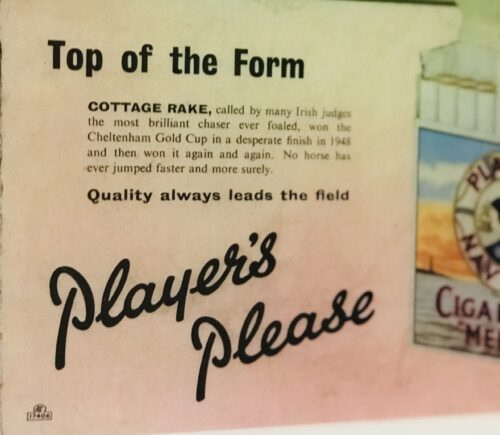
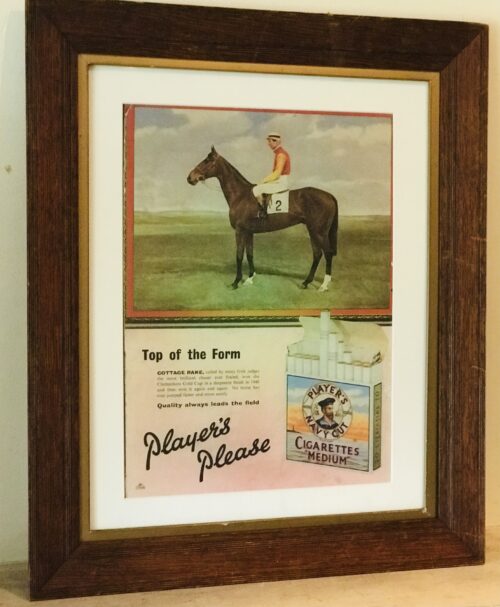 55cm x 45cm Doneraile Co Cork Classic Players Please Navy Cut advertising showcard depicting the great steeplechaser Cottage Rake with regular jockey Aubrey Brabazon on board.The advert states boldly "Cottage Rake,called by many Irish judges the most brilliant chaser ever foaled, won the Cheltenham Gold Cup in a desperate finish in 1948 and then won it again and again.No horse has ever jumped faster and more surely-Quality always leads the field." Aside from the ad mens claims and in a generation before the arrival of the great Arkle,theres no doubting the greatness of Cottage Rake. His breeder was Richard Vaughan from Hunting Hall, Castletown Roche, Co. Cork, Ireland. Before he embarked on his jumping career, he was failed by a vet on three different examinations. On the last of these occasions, the vet was overheard by young trainer Vincent O'Brien saying that the horse's wind infirmity would not interfere with his racing performance. O'Brien contacted wool merchant Frank Vickerman who bought the horse to be trained by O'Brien. Cottage Rake ultimately set his trainer on the route to the top of the training ladder by becoming only the second horse to win the Cheltenham Gold Cup three years in a row. He achieved this hat trick from 1948–1950, beating Finnure by ten lengths in the last of these races. His hardest-won triumph had come the previous year when he only got the better of Cool Customer in the final 100 yards. Such was his partnership with jockey Aubrey Brabazon that a verse was composed about their success. Cottage Rake lost his form after his third Cheltenham Gold Cup triumph. He moved over to Gerald Balding's stable in England, but the change of scenery did not resurrect his success.
55cm x 45cm Doneraile Co Cork Classic Players Please Navy Cut advertising showcard depicting the great steeplechaser Cottage Rake with regular jockey Aubrey Brabazon on board.The advert states boldly "Cottage Rake,called by many Irish judges the most brilliant chaser ever foaled, won the Cheltenham Gold Cup in a desperate finish in 1948 and then won it again and again.No horse has ever jumped faster and more surely-Quality always leads the field." Aside from the ad mens claims and in a generation before the arrival of the great Arkle,theres no doubting the greatness of Cottage Rake. His breeder was Richard Vaughan from Hunting Hall, Castletown Roche, Co. Cork, Ireland. Before he embarked on his jumping career, he was failed by a vet on three different examinations. On the last of these occasions, the vet was overheard by young trainer Vincent O'Brien saying that the horse's wind infirmity would not interfere with his racing performance. O'Brien contacted wool merchant Frank Vickerman who bought the horse to be trained by O'Brien. Cottage Rake ultimately set his trainer on the route to the top of the training ladder by becoming only the second horse to win the Cheltenham Gold Cup three years in a row. He achieved this hat trick from 1948–1950, beating Finnure by ten lengths in the last of these races. His hardest-won triumph had come the previous year when he only got the better of Cool Customer in the final 100 yards. Such was his partnership with jockey Aubrey Brabazon that a verse was composed about their success. Cottage Rake lost his form after his third Cheltenham Gold Cup triumph. He moved over to Gerald Balding's stable in England, but the change of scenery did not resurrect his success. -
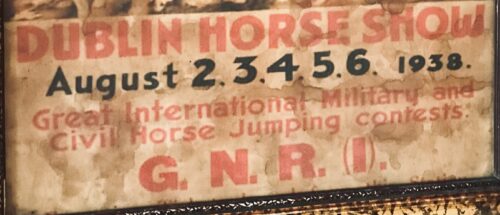
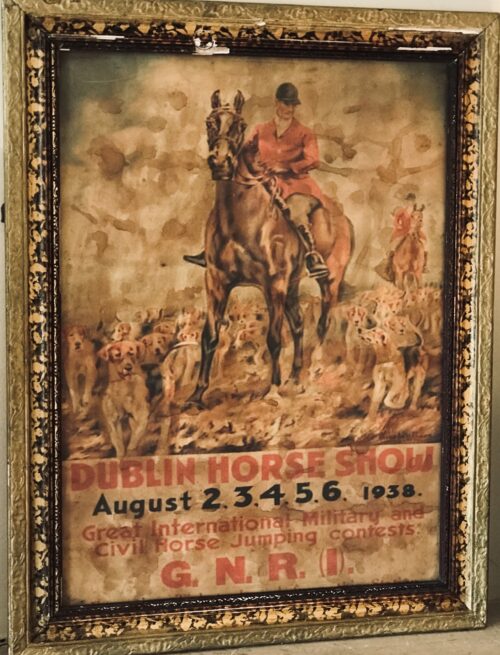 60cm x 45cm Naas Co Kildare RDS (Royal Dublin Society) Dublin Horse Show advertising print from 1938 featuring a beautiful image of a huntsman on horseback with working hounds . The advert was printed by Alex Thom & Co Ltd Dublin and also describes the various modes of transport available to prospective horseshow goers, namely the GNR or Great Northern Railway.The event ,similar to current day took place from August 2nd to August 5th. Founded in 1876,the GNR was a merger between the Irish North Western Railway,Northern Railway of Ireland and Ulster Railway.The company was nationalised later in 1953 before being finally liquidated 5 years later with its assets divided upon national lines between the Ulster Transport Authority & Ćoras Iompair Éireann (CIE). The first Dublin Horse Show took place in 1864 and was operated in conjunction with the Royal Agricultural Society of Ireland. The first solely Society-run Horse Show was held in 1868 and was one of the earliest "leaping" competitions ever held.Over time it has become a high-profile International show jumping competition, national showing competition and major entertainment event in Ireland. In 1982 the RDS hosted the Show Jumping World Championshipsand incorporated it into the Dublin Horse Show of that year. The Dublin Horse Show has an array of national & international show jumping competitions and world class equestrian entertainment, great shopping, delicious food, music & fantastic daily entertainment. There are over 130 classes at the Show and they can be generally categorised into the following types of equestrian competitions: showing classes, performance classes and showjumping classes.
60cm x 45cm Naas Co Kildare RDS (Royal Dublin Society) Dublin Horse Show advertising print from 1938 featuring a beautiful image of a huntsman on horseback with working hounds . The advert was printed by Alex Thom & Co Ltd Dublin and also describes the various modes of transport available to prospective horseshow goers, namely the GNR or Great Northern Railway.The event ,similar to current day took place from August 2nd to August 5th. Founded in 1876,the GNR was a merger between the Irish North Western Railway,Northern Railway of Ireland and Ulster Railway.The company was nationalised later in 1953 before being finally liquidated 5 years later with its assets divided upon national lines between the Ulster Transport Authority & Ćoras Iompair Éireann (CIE). The first Dublin Horse Show took place in 1864 and was operated in conjunction with the Royal Agricultural Society of Ireland. The first solely Society-run Horse Show was held in 1868 and was one of the earliest "leaping" competitions ever held.Over time it has become a high-profile International show jumping competition, national showing competition and major entertainment event in Ireland. In 1982 the RDS hosted the Show Jumping World Championshipsand incorporated it into the Dublin Horse Show of that year. The Dublin Horse Show has an array of national & international show jumping competitions and world class equestrian entertainment, great shopping, delicious food, music & fantastic daily entertainment. There are over 130 classes at the Show and they can be generally categorised into the following types of equestrian competitions: showing classes, performance classes and showjumping classes.- The first show was held in 1864 under the auspices of the Society, but organised by the Royal Agricultural Society of Ireland.
- There were 366 entries in the first Show with a total prize fund of £520.
- On the 28, 29 and 30 July 1868 the first show was held and organised by the Royal Dublin Society on the lawns of Leinster House. The Council granted £100 out of the Society's funds to be awarded in prizes. It started as a show of led-horses and featured ‘leaping' demonstrations.
- The first prize for the Stone Wall competition (6ft) in 1868 was won by Richard Flynn on hunter, Shane Rhue (who sold for £1,000 later that day).
- Ass and mule classes were listed at the first show!
- In 1869 the first Challenge Cup was presented for the best exhibit in the classes for hunters and young horses likely to make hunters.
- In 1870 the Show was named ‘The National Horse Show', taking place on the 16-19 August. It was combined with the Annual Sheep Show organised by the Society.
- 1869 was the year ‘horse leaping' came to prominence. There was the high leap over hurdles trimmed with gorse; the wall jump over a loose stone wall of progressive height not exceeding 6 feet; and the wide leap over 2 ½ ft gorse-filled hurdle with 12 ft of water on the far side.
- The original rules for the leaping competitions were simply ‘the obstacles had to be cleared to the satisfaction of the judges'.
- The prizes for the high and wide leaps were £5 for first and £2 for second with £10 and a cup to the winner of the championship and a riding crop and a fiver to the runner up.
- In 1881 the Show moved to ‘Ball's Bridge', a greenfield site. The first continuous ‘leaping' course was introduced at the Show.
- In 1881 the first viewing stand was erected on the site of the present Grand Stand. It held 800 people.
- With over 800 entries in the Show in 1895, it was necessary to run the jumping competitors off in pairs - causing difficulties for the judges at the time!
- Women first took part in jumping competitions from 1919.
- A class for women was introduced that year on the second day of the Show (Wednesday was the second day of the Show in 1919. Ladies' Day moved to Thursday, the second day, when the Show went from six to five days). Quickly after that, from the 1920s onwards, women were able to compete freely in many competitions at the Show.
- Women competed in international competitions representing their country shortly after WWII.
- As the first "Ladies' Jumping Competition" was held on the second day of the Show this day become known as Ladies' Day. A name that has stuck ever since.
- In 1925 Colonel Zeigler of the Swiss Army first suggested holding an international jumping event. The Aga Khan of the time heard of this proposal and offered a challenge trophy to the winner of the competition.
- In 1926 International Competitions were introduced to the show and was the first time the Nations' Cup for the Aga Khan Challenge trophy was held.
- Six countries competed in the first international teams competition for the Aga Khan Challenge trophy - Great Britain, Holland, Belgium, France, Switzerland and Ireland. The Swiss team won the title on Irish bred horses.
- The Swiss team won out the original trophy in 1930. Ireland won the first replacement in 1937 and another in 1979, Britain in 1953 and 1975. The present trophy is the sixth in the series and was presented by His Highness the Aga Khan in 1980.
- Up until 1949 the Nations' Cup teams had to consist of military officers.
- The first Grand Prix (Irish Trophy) held in 1934 was won by Comdt.J.D.(Jed) O'Dwyer, of the Army Equitation school. The Irish Trophy becomes the possession of the rider if it is won three times in succession or four times in all.
- The first timed jumping competition was held in 1938. In 1951 an electric clock was installed and the time factor entered most competitions.
- In 1976, after 50 years of international competition, the two grass banks in the Arena were removed so the Arena could be used for other events. The continental band at the western end of the Main Arena was added later.
- Shows have been held annually except from 1914-1919 due to WW1 and from 1940-1946 due to WW2.
- In 2003 the Nations Cup Competition for the Aga Khan Trophy became part of the Samsung Super League under the auspices of the Federation Equestre Internationale.
- The Nations Cup Competition for the Aga Khan Trophy is part of the Longines FEI Jumping Nations Cup™ Series.
- The Dublin Horse Show is Ireland's largest equestrian event, and one of the largest events held on the island.
- The Show has one of the largest annual prize pools for international show jumping in the world.
-
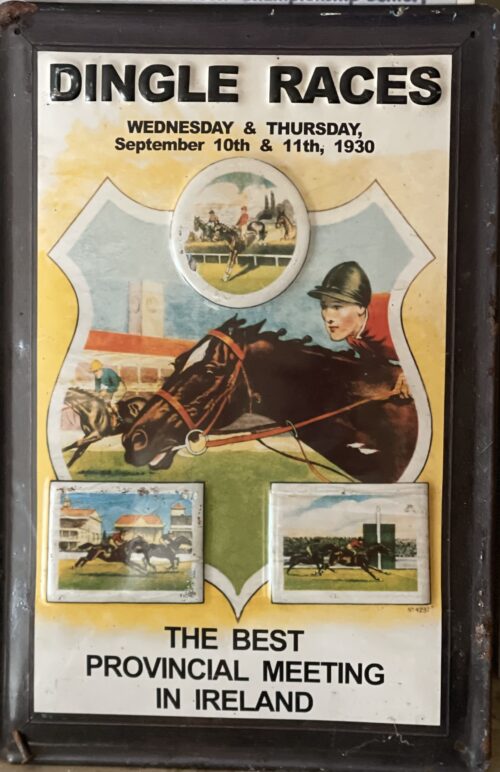
 29cm x 20cm Ireland’s Largest & Best Horse & Pony Meeting. Every year in August, the field at Ballintaggart changes into an enormous racetrack filled with horses, jockeys and horse racing enthusiasts from all over Ireland and the rest of the world. No less than 20 races are held with a total prize fund of €40,000! The centre of the racecourse is filled with bouncing castles, fortune-tellers and fair stands that sell everything from bouncing balls to saddler's sponges. Entertainment for the whole family!
29cm x 20cm Ireland’s Largest & Best Horse & Pony Meeting. Every year in August, the field at Ballintaggart changes into an enormous racetrack filled with horses, jockeys and horse racing enthusiasts from all over Ireland and the rest of the world. No less than 20 races are held with a total prize fund of €40,000! The centre of the racecourse is filled with bouncing castles, fortune-tellers and fair stands that sell everything from bouncing balls to saddler's sponges. Entertainment for the whole family!

